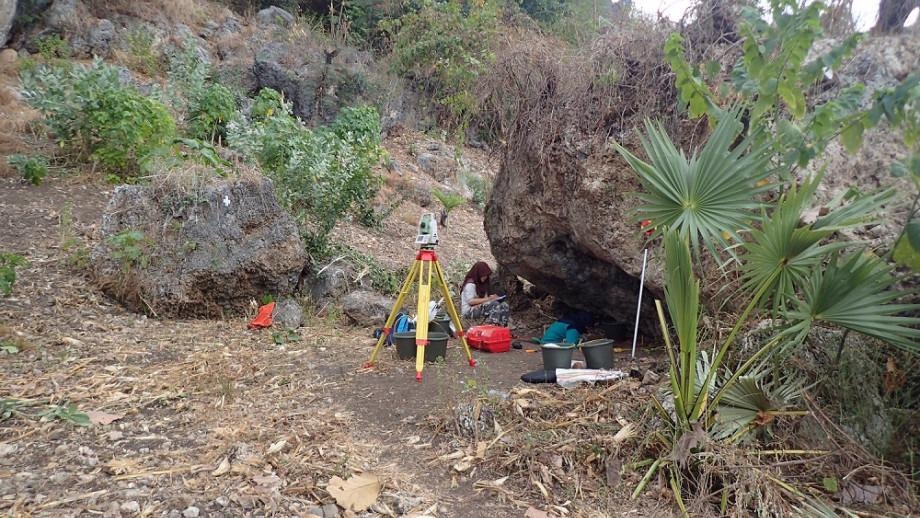Reviewed by Danielle Ellis, B.Sc.Jun 13 2022
An “explosion” of intermixing cultures and genetics in Wallacea, an island region north of Australia, has been revealed through DNA analysis of ancient human remains, leaving an imprint that can still be seen in East Indonesians today.
 Excavation in progress at Jareng Bori rockshelter in Pantar island. Image Credit: Dr Stuart Hawkins/ANU
Excavation in progress at Jareng Bori rockshelter in Pantar island. Image Credit: Dr Stuart Hawkins/ANU
Scientists from The Australian National University (ANU) and the Max Planck Institutes in Germany led the research, which is the first to use ancient DNA analysis to define the substantial maritime migration of Austronesian-speaking peoples out of Taiwan, southern China, and the Philippines into Wallacea from an ancient genetic point of view. Between 3,000 and 3,500 years ago, there was a massive migration.
These ancient migratory peoples interacted with local indigenous groups from Wallacea and Papua, resulting in a genetic footprint that is thought to have left its mark on many of the Asia-Pacific islands, according to the research.
Professor Sue O’Connor, a co-author of the study, said Austronesian-speaking peoples brought domestic animals, crops, and pottery to the Wallacean islands, as well as other cultural and social practices that have developed over thousands of years.
This research shows for the first time what a tremendous genetic melting pot the islands to Australia’s north are.”
Sue O’Connor, Study Co-Author and Professor, The Australian National University
“It also gives us a unique insight into the amount of human mobility that took place across this vast maritime region that we wouldn’t get from archaeology alone; the migration of the Austronesian people across the Pacific is one of the greatest migrations in human history,” she said.
Most of those Austronesian peoples who lived in the Wallacean islands, according to the authors of the study, journeyed all across the Pacific and may have even sailed as far as South America, though there is no indication that they did so permanently or if they settled in Australia.
“Our paper demonstrates that this intertwining of genetics and cultures in the Wallacea region occurred at least a millennium earlier than previously thought, and also that this was continuous during the Neolithic and Metal Age periods of the last 3,000 years,” Dr Stuart Hawkins, who was also involved in the study, said.
“We also know the arrival of the Austronesian-speaking peoples coincided with a period that saw great transformations in society not too dissimilar to how society is being transformed in Australia today,” Dr Hawkins added.
“The presence of elaborate pottery, food production, rock art depictions, a sun-orientated ideology, and advanced sailing boats after 3,000 years is quite dramatic for this time.”
Historically, it was thought that Austronesian peoples were the most common migrants to Wallacea during this time. However, based on the DNA evidence identified in this research, migrants from Mainland Southeast Asia landed in Wallacea’s southern islands before the Austronesians.
“That mainland Southeast Asian component is a great mystery to me. I suspect that we might be looking at small groups, perhaps of early farmers, who travelled a long way, left no archaeological or linguistic traces along the way, but who increased their population sizes after arrival,” Emeritus Professor Peter Bellwood, who has spent decades working as an archaeologist in Southeast Asia’s islands, stated.
Professor O’Connor said, “While this is a surprise in some ways, there have long been hints in the archaeological evidence that there was an early movement of people from Mainland Southeast Asia, such as finds of pottery sherds in archaeological sites which didn’t quite fit with what we know of early Austronesian pottery.”
The researchers examined DNA from 16 ancient individuals from several islands in the Wallacea region, notably Pantar Island in Indonesia and analyzed it.
Some of the human remains discovered, like those discovered by Emeritus Professor Bellwood in the northern Moluccas Islands, in the 1990s. However, thanks to substantial scientific developments in DNA testing procedures, DNA could not be successfully recovered from the bones until recently.